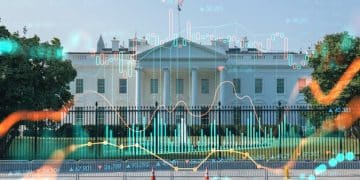US Trade Deficit: Understanding Import/Export Trends & Impacts

The US trade deficit reflects the difference between the value of goods and services the United States imports versus what it exports, revealing crucial insights into the nation’s economic health and global trade relationships.
The US Trade Deficit: Understanding the Implications of Current Import/Export Trends is crucial for grasping America’s position in the global economy. This article explores what this deficit means, its causes, and its effects on the US.
What is the US Trade Deficit?
The trade deficit occurs when a country imports more goods and services than it exports. For the United States, understanding this balance is vital for assessing economic performance and international trade relations.
Simply put, think of imports as what the US buys from other countries and exports as what the US sells to other countries. When the purchases exceed the sales, you have a trade deficit.
Key Components of the Trade Deficit
Several factors contribute to the trade deficit, including the types of goods traded and the economic conditions affecting trade volumes.
- Goods vs. Services: The US often has a trade deficit in goods but a surplus in services. Think of goods as physical products and services as things like tourism, finance, and technology services.
- Major Trading Partners: Understanding which countries the US trades with the most helps to identify specific areas of imbalance.
- Economic Conditions: Both domestic and global economic conditions impact the trade deficit, influencing import and export levels.
In essence, the trade deficit is not just about numbers; it reflects the real economic interactions between the United States and the rest of the world.

Historical Trends of the US Trade Deficit
Looking at the historical trends of the US trade deficit provides context to its current status. Reviewing past figures helps understand the cyclical nature of the trade balance and potential long-term patterns impacting the economy.
Over the decades, the US trade deficit has seen considerable fluctuations influenced by various economic events and policy changes.
Key Historical Periods
Analyzing specific periods offers insight into how different factors have shaped the trade deficit.
- Post-World War II Era: The US initially had trade surpluses as it led the global economy.
- 1980s and 1990s: The rise of global manufacturing and increased imports led to growing deficits.
- 2000s: The deficit widened significantly due to factors like increased oil imports and trade imbalances with countries like China.
Examining these trends helps to appreciate the dynamic nature of trade and the factors that drive the US trade deficit.
Factors Contributing to the Trade Deficit
Several factors play a role in the US trade deficit, each contributing in unique ways. Understanding these factors is essential for formulating trade policies and economic strategies.
From macroeconomic influences to industry-specific issues, various elements shape the trade balance.
Economic Policies
Government policies can significantly alter trade dynamics.
Trade agreements often influence imports and exports. Tax incentives and tariffs can shift the competitiveness of domestic industries. Currency valuation affects the cost of goods traded internationally.
Global Economic Conditions
Global economic factors also play a crucial role.
Economic growth in other countries can increase demand for US exports. Fluctuations in commodity prices, like oil, can impact import costs. Global competition can affect the competitiveness of US industries.
Examining these elements provides a holistic view of the various economic forces affecting the trade deficit.

Impact of the Trade Deficit on the US Economy
The trade deficit has numerous impacts on the US economy, both positive and negative. Assessing these effects is critical for understanding the broader economic consequences.
These consequences span from job creation and income levels to national debt and economic growth.
Job Creation and Employment
The impact on employment is a key concern.
Some argue deficits can lead to job losses in industries that face import competition. Others say that increased imports can lower costs for businesses and consumers, leading to job growth in other sectors. The net effect on employment is complex and varies by industry.
National Debt and Economic Growth
The trade deficit affects the national debt and overall economic growth.
Financing the trade deficit often requires borrowing from abroad, which can increase the national debt. The impact on GDP growth depends on how the borrowed funds are invested. If spent on productive assets, it could boost long-term growth. However, excessive borrowing can lead to financial instability.
Looking at these factors provides a balanced perspective on the economic implications of the trade deficit.
Strategies for Reducing the Trade Deficit
Several strategies exist for reducing the US trade deficit, each with its own set of benefits and challenges. Understanding these approaches is important for policymakers and businesses.
From promoting exports to restructuring trade agreements, various methods can influence the trade balance.
Promoting Exports
Encouraging exports is a direct way to decrease the trade deficit.
Government incentives such as export subsidies and tax breaks can help domestic companies sell more goods abroad. Trade promotion events and missions can open doors for US businesses in international markets. Efforts to reduce trade barriers in other countries can also facilitate exports.
Restructuring Trade Agreements
Renegotiating trade agreements can lead to more favorable trade terms.
Seeking fairer access to foreign markets can increase exports. Adjusting tariffs and quotas can balance trade flows. Ensuring strong enforcement of trade rules can prevent unfair trade practices.
By assessing these strategies, policymakers can make informed decisions about how to address the trade deficit.
Future Outlook for US Trade
The future outlook for US trade will be influenced by several evolving trends and emerging challenges. Understanding these future dynamics is crucial for shaping policies and business strategies.
From technological advancements to geopolitical shifts, numerous factors will shape trade relationships.
Technological Transformations
Technology will continue to reshape global trade.
Advances in automation may shift production locations and affect the types of goods traded. E-commerce platforms will continue to expand cross-border trade opportunities. Digital technologies will play an increasing role in service exports.
Geopolitical Factors
Geopolitical events and shifts in global power dynamics will impact trade relations.
Changes in international alliances can alter trade patterns. Trade disputes and conflicts can create uncertainty. Emerging economies will play an increasingly important role in global trade.
By considering these trends, policymakers and businesses can prepare for the future of US trade and its evolving landscape.
| Key Point | Brief Description |
|---|---|
| 📊 Trade Deficit Defined | Imports exceed exports, indicating more buying than selling. |
| 📈 Historical Trends | Fluctuations due to global events and policy changes. |
| 💼 Key Factors | Economic policies & global conditions drive trade balance. |
| 🌍 Future Outlook | Technology & geopolitics will reshape US trade. |
Frequently Asked Questions
▼
The US trade deficit is when the value of imports exceeds exports. It matters because it reflects the country’s economic health and its reliance on foreign goods and services, which can impact jobs and economic growth.
▼
The main factors are consumer demand for foreign goods, comparative production costs (often cheaper abroad), currency valuation, and global economic conditions. Government policies and trade agreements also play a significant role.
▼
The trade deficit’s effect on employment is debated. Some argue that it leads to job losses in industries competing with imports. Others suggest it lowers consumer costs and creates opportunities in other sectors, resulting in a mixed impact.
▼
Reducing the trade deficit *could* benefit the US economy by boosting domestic production, creating jobs, and reducing reliance on foreign borrowing. However, it depends on how it’s achieved and whether broader economic policies support growth.
▼
Strategies include promoting exports through incentives and trade missions, renegotiating trade agreements for fairer terms, reducing trade barriers, and investing in domestic industries to make them more competitive globally.
Conclusion
Understanding the nuances of the US Trade Deficit: Understanding the Implications of Current Import/Export Trends is essential for anyone looking to grasp the complexities of the US economy. By analyzing historical trends, key influencing factors, and potential future outlooks, policymakers, businesses, and individuals alike can make more informed decisions about the nation’s role in global trade.





